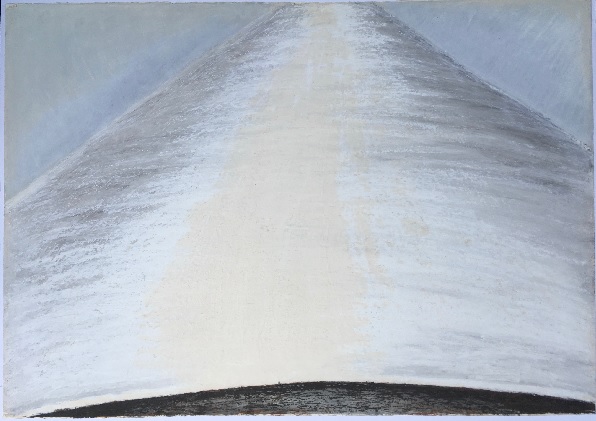
Marie Schoeff
March-East, 1979
Oil stick on paper
27 ¾ x 39 ½ in.

"Art is a process by which we can make concrete our vision and thus share our understanding of what it means to be human." - Marie Schoeff
COMMENTS
Dr. Judy L. Larson, Director of the Westmont Ridley-Tree Museum of Art, interviewed Marie Schoeff about the trace drawings and the dry point prints in TRACES, her exhibition at Jane Deering Gallery. Below are excerpts from that conversation. Dr. Larson began with a question about the two print processes Ms. Schoeff displays in this exhibit.
Marie Schoeff: Over the years I have tried various printmaking techniques, although I never studied it in school. My husband, artist Dane Goodman, encouraged me to try trace drawings. This simple, low-tech process instantly engaged me. Then, shortly after making the trace drawings, I began delving further into printmaking. Working with a master printer, Elaine LeVasseur, I tried wood block, collagraph, and dry point processes. I was immediately taken by dry point and its direct connection to drawing. I struggled making my lines with the traditional metal scribe; then tried a Dremel tool, but finally found that drawing with a soldering iron on Plexiglas gave me the most fluid marks.
Judy Larson: I find that the images in the dry points carry a theme of animation in their rhythmic movement. The large size also adds energy. Every time I look at these forms I see this tension of pent up movement about to whirl into my space. The Coils hold a particularly strong sense of movement. However, I notice a difference between your dry points and the trace drawings that focus more clearly on the female form.
Schoeff: I began the trace drawings by using images from my recent paintings: the female body and coverings for the body, skirts and veils. I wanted to take the figural elements in the paintings back to their more spontaneous origins -- the gestures from my sketchbook notations. I love how the trace drawing process amplifies my nuanced lines, making them more dramatic. Also, the process yields a transitional sequence of images. Using ghost and reworked ghost prints I’m able to create generations of related works.
Larson: With such a simple technique, you are able to achieve many unusual effects in the trace drawings.
Schoeff: Yes, and many of the effects are unexpected. For instance, if I work the ink brayer back and forth on the plate, grainy textures appear that look like a fingerprint. Or if dust gets on the plate, the ink doesn’t take hold where the dust is and creates wonderful white spots. These patterns are impossible to draw -- they emerged, as surprises, through this process. I like that the process gives something back to me as I work, letting me surrender some control.
Larson: What tools do you use in creating the trace drawings?
Schoeff: At first I used sticks, my fingers, the palm of my hand,
erasers – in other words, tools that left no marks. I realized I wanted
to record the original act of drawing, so I began dipping my fingers in charcoal dust to leave evidence of my work. These marks produce the drawings you see on the back of the prints – this drawn side represents the beginning.
Larson: In the prints titled Piggyback you have two subtle, beautiful body images. You never force the figure in these drawings; instead you seem to merely suggest it, creating mystery. I find the female forms in the Barbie drawings more literal.
Schoeff: Yes, the Barbie images were inspired from drawings my daughter did when she 11 years old. She repeatedly made simple outlines of classic females with hourglass figures, the archetype of feminine beauty.
I believe we all have a natural capacity to create images and use them to grapple with our humanity. My daughter’s drawings reveal a young girl’s perception of what it is to be female. I am intrigued with depictions of the female form across time and cultures – the ancient Venus figures, Cycladic carvings, and early Asian statues as well as the modern Barbie doll.
Larson: I like the feminist connection not only in your exploration of the female form, but in using your young daughter’s fascination with the figure as the genesis for a new perspective – that’s a new twist. Your imagery of the female form is inspired from life, but you let your subconscious mind revise these images in meaningful ways.
Schoeff: Carl Jung’s theories on archetypes, dreams, symbolism, and the collective unconscious are a major influence on me, particularly his premise that humans are innately image-makers. My studies of Jung’s work encouraged me to pursue my own pictorial language, with faith in its ability to connect to others on a more primal level. I see my lines and forms as stand-ins for the female body and references to universal experiences.
Larson: Where does your exhibition title come from?
Schoeff: On the surface, Traces refers to the trace drawings and the act of drawing. To draw is to leave a remnant of the movement of the hand as it follows the eye or the imagination of the maker. A trace is evidence of this activity and of something that existed but is now gone. It is a memory made tangible. On a deeper level, Traces alludes to absence, memory, and loss -- all signifying the source of what is left behind.
Larson: How do these works function as a vehicle for expressing your life?
Schoeff: They are reflections upon being a woman, a mother, and a daughter. Drawing for me is a meditative process linking the ordinary with the spiritual. I suppose my work traces my life experience.
Marie Schoeff has had solo exhibitions in New York City, Los Angeles, San Francisco and Santa Barbara. Her works are in numerous museum, private and corporate collections. She received her MFA in Painting and Drawing from Hunter College in New York City.
Dr. Judy L. Larson is Director of the Westmont Ridley-Tree Museum of Art and holds the R. Anthony Askew Chair in Art History at Westmont College in Santa Barbara. Previously she was Director of the National Museum of Women in the Arts in Washington, D.C., where she organized numerous exhibitions on global contemporary women artists.
https://www.marieschoeff.com/interview-2012
SBMA CURATORIAL LABELS
Marie Schoeff is engaged with ideas of memory and loss, and the potential of abstract forms to trigger individual experiences in the viewer. These drawings represent her early explorations into abstraction and representation. Two are named for the street where she resided in New York, yet all of them are meant to combine real locations with those conjured from memory.
Produced intuitively, Schoeff’s atmospheric abstractions evoke an ambiguous sense of place. Using oil stick, the artist employs gestures that indicate not only a human presence but also a sense of texture and materiality. By surrendering some control in this practice, she allows the image to emerge organically from the process itself. Schoeff’s interest in drawing and painting has expanded throughout her oeuvre, and in recent years she has also incorporated her own hand-made paper. She has also turned to different modes of abstraction, including spontaneous, fluid, and often linear forms that recall the female body and evoke movement.
- Summer Nocturne, 2018
